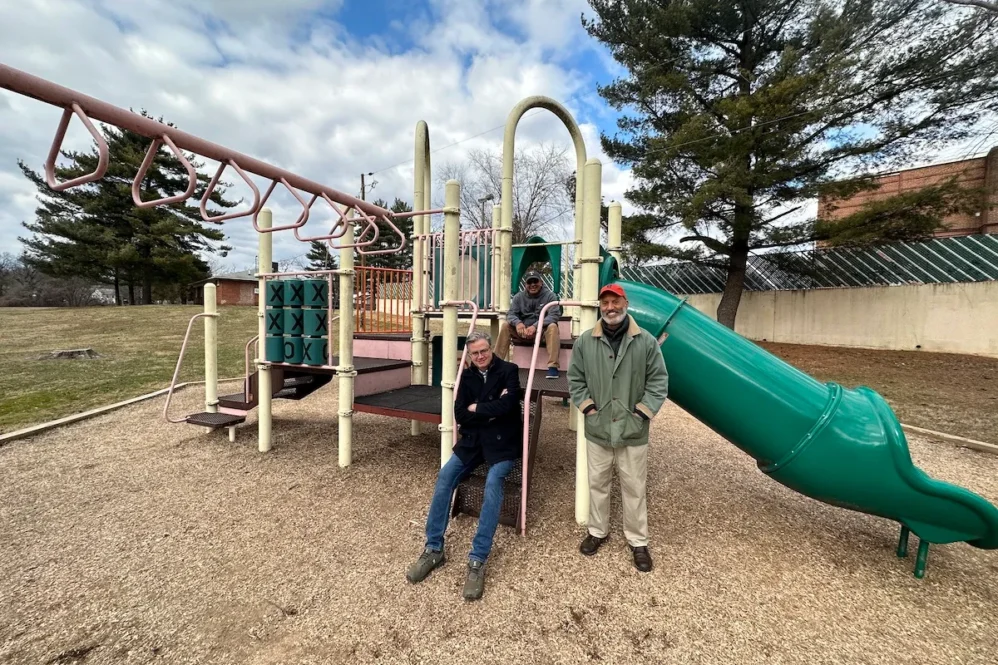WASHINGTON INFORMER: Every morning, 70-year-old Al Powell takes long walks on the Sligo Creek Trail, covering miles of well-paved track alongside the burbling water. It’s an incredibly convenient place to walk for Powell: the trail and the creek run right past his home in Hyattsville, where he has lived since 1974. He and his wife, Geeta Powell, can see the path from their backyard.
Most days, the two sit next to each other on the swing bench set up on their back patio and watch folks run, walk and bike on the trail, which sits within Parklawn Park. The daily commitment to—and delight in—his neighborhood’s outdoor space gave Powell cause for alarm when he found out about a proposal to build a 16-pump gas station less than 600 feet from his back door.
Geeta has asthma; Al didn’t want her to breathe in gas fumes day in and day out. He also didn’t want to see the tiny playground right behind the site torn down—a requirement for the Royal Farms gas station to meet zoning standards. For years, the Powells’ five grandchildren and three great-grandchildren have played there during their visits.
Besides, Al Powell said, that intersection—Riggs Road and East-West Highway—already has a gas station, an Exxon across the street. He didn’t need or want another one.
So Powell decided to say something. He joined an effort spearheaded by a handful of residents from the Carole Highlands neighborhood, about a mile northwest, to fight Royal Farms’ proposal. The group organized 11 citizens living nearby to give testimony at a zoning hearing about the project. A little over five months later, on Jan. 12, the company withdrew its zoning application.
By then, the project faced an active group of oppositional residents and the pro bono legal representation they had called in for help, as well as a newly elected County Council hostile to the project. On Monday, that Council voted 9-0 to officially accept the application’s withdrawal, closing the matter for good.
“Sometimes it feels like these companies, they’re just going to do what they want. But sometimes you can stop things if you put in the effort,” Powell said.
The lawyer for Royal Farms, Matthew Tedesco, declined to comment for this story, including on why his client, RF East West Hyattsville LLC, decided to withdraw the application.
‘The More We Learn About the Project, the Worse It Looks’
Walking in a wide loop around the park land surrounding his house, Powell recalled several flooding events he witnessed over the years. In 1976, he said, the creek rose high enough to reach the proposed gas station site. Then on September 10, 2020, severe flooding hit the whole DMV region hard. Near Hyattsville and Chillum, the water flooded homes and tore up roads.
“There were logs rolling down the highway,” Powell said of the 2020 flood.
In July of this year, Sligo Creek rose to a record seven feet as thunderstorms deluged the region. The East-West Highway/Riggs Road intersection—the site of the proposal—shut down as the creek overflowed its banks.
The southeastern edge of the property that Royal Farms sought fell in the 100-year floodplain. In its current, empty state, the parking lot has no stormwater management. Royal Farms’ site plan included landscaping and grading features aimed at reducing flooding, according to zoning hearing testimony from Joseph DiMarco, a civil engineer who worked on the plans. DiMarco also said that the underground fuel tanks would have been located outside the designated floodplain line.
Still, area residents remained concerned.
“Say those tanks don’t leak—you’re still going to have all the other things associated with a fuel filling station. If you’ve ever filled up your car, you know: sometimes you spill, or you’re putting the hose back and it spills,” said Jason Clayton, president of the Carole Highlands Neighborhood Association. “Being in a floodplain, when we get heavy rains, all that stuff is going to wash somewhere, and it’s going to be downhill and into the creek.”
That worry is backed up by research: a 2014 study in the Journal of Contaminant Hydrology examined the extent of chronic, small spills at gas stations and found that the cumulative impact likely added up to “non-negligible human exposure” to harmful chemicals. In general, research has linked living near gas stations to increased risks for childhood leukemia and other cancers, according to a study published in the Journal of Environment Health Science & Engineering in 2021.
There are more than 20 gas stations within a mile and a half of the proposed Royal Farms, one Carole Highlands resident said in his testimony opposing the proposal.
The main toxin associated with gas stations is benzene, a carcinogenic. The likelihood of benzene to end up in the nearby waterway brought Michael Wilpers, chair of natural history for Friends of Sligo Creek, into the fight. Another gas station less than 300 feet from the creek threatened the plants and animals that lived there, he argued, as well as their human neighbors.
For Wilpers, who lives just across the border in Montgomery County, it was also a question of fairness. Montgomery County’s zoning rules prohibit gas stations designed to sell more than 3.6 million gallons a year from being built within 500 feet of residences, schools, day cares, playgrounds, parks and environmentally sensitive areas—including streams and floodplains. Of that list, the Prince George’s County zoning code only regulates gas station distance from playgrounds and schools.
“This gas station wouldn’t have gotten off first base if they tried to do it in Montgomery County, because it’s not even an inch away from a park—it shares a boundary,” Wilpers said. “Why should animals, plants and people in Prince George’s be exposed to more airborne poisons than people in Montgomery County?”
Ten nearby residents, including Wilpers, Clayton and Powell, presented these arguments in their testimony during the zoning hearing on Aug. 3. Others, including former president of the Carole Highlands Neighborhood Association Jeff Cronin, also pointed out that the project seemed contradictory to the countywide Climate Action Plan adopted by the Prince George’s County Council just this past July. The plan calls for reducing emissions by 50% by 2030 (compared to 2005 levels).
Cronin first heard about the proposed gas station by accident, during a June 25 walking tour with county planning staff and officials. The tour focused on improving walkability and pedestrian safety in the area; the gas station plan came up in passing. On July 7, Cronin posted a message to the Carole Highlands Neighborhood Association email group about the project and his plans to oppose it.
“The more we learn about the project the worse it looks, especially from an environmental perspective,” he wrote in a follow-up message on Aug. 1 of last year.
People living nearby had concerns about several non-environmental issues as well. Powell and others worried about additional traffic at an intersection where they described regularly seeing severe accidents. One Maryland injury law firm listed the spot as one of the top ten most dangerous intersections where it saw repeated collisions throughout Montgomery, Prince George’s, and Charles counties.
Mark Ferguson, who prepared the land planning report for Royal Farms, testified at the hearing that the project would improve traffic safety, because the site plan would close off one access point on East-West Highway and adjust the lanes around the other entrance. He also said that his analysis showed fewer additional trips to the intersection than occur with the present use of the site.
Powell, who said he sees a traffic incident at the intersection at least once a week, was not convinced. “The traffic would’ve been nasty,” he said.
Further, no one wanted to lose the playground. The Maryland-National Capital Park and Planning Commission had come to the conclusion that the tiny configuration of green slides and yellow monkey bars was “not heavily used,” according to the Technical Staff Report the agency produced. But both Powell and Clayton fondly recalled bringing a child or grandchild to play there.
Some, including a registered dietitian who testified at the hearing, also argued that gas station food—including fried chicken, burgers and fries—would not serve as a good replacement for the Salvadoran restaurant currently on the site. Cronin pointed out, citing Royal Farms’ own data, that 36% of the company’s store revenue comes from tobacco.
“If this project moves forward… we would trade exercise equipment for children and culinary diversity in exchange for fast food, fossil fuels, and finally, cigarettes,” Cronin said at the zoning hearing.
Based on the testimony and the technical recommendations of Prince George’s County planning staff, the Zoning Hearing Examiner approved Royal Farms’ request on Oct. 7.
Cronin and the others had expected as much. They had to decide if they would put in the many extra hours needed to file an appeal—and if they even had a chance to win it.
‘Handed to Them on a Silver Platter’
The site proposed for the new gas station hardly appears, on its face, like a place that would inspire a heated battle. The most striking feature of the strip mall is a big parking lot.
In over four decades living next door, Powell has seen the site host a number of different occupants, including a Safeway, a Pottery Barn, a plant shop and, most recently, a Rite Aid. Now, a Papa John’s and a highly rated Salvadoran restaurant called Comedor San Alejo fill part of the building, but the rest remains empty.
Few passing motorists would suspect that a well-loved park, complete with a creek, a trail and a playground, lies beyond the mostly-empty building and expanse of asphalt.
“The status quo isn’t doing anyone any favors,” Cronin said of the spot.
But when he heard about the project during the pedestrian safety walking tour, Cronin thought that another gas station “would have made everything worse—it’d be bad for the creek and bad for the neighbors.” That’s why he reached out to his own neighborhood association email group.
A flurry of messages followed Cronin’s initial one, and a smaller group of interested neighborhood association members formed to talk strategy. Within their community, they recruited a professor of urban planning and a registered dietitian to speak on the record, adding an extra layer of credibility to their testimony.
The group had just over a month between first learning about the proposed gas station and the scheduled zoning hearing, where Royal Farms would argue in favor of its application for a Special Exception. The project required the zoning exception because Prince George’s County does not allow gas stations within 300 feet of playgrounds.
Luckily for Royal Farms, the Maryland-National Capital Park and Planning Commission, a joint agency serving Prince George’s and Montgomery County, had already agreed to remove the playground equipment before construction began. In exchange, Royal Farms would spend up to $400,000—the estimated cost of the playground equipment—on beautification and landscaping in Parklawn Park.
The agency’s Department of Parks and Recreation had been in talks with Royal Farms since at least October 2021, according to an official agreement between the two parties signed in late August of this year. The department staff had determined that the playground was “not heavily used” and that the equipment would “be slated for replacement or removal in the near term” regardless, according to a Jan. 3 memo.
The playground was almost 40 years old, according to Jeremy Hurlbutt, the planning supervisor for zoning at Prince George’s County Planning Department. Hurlbutt also said that the site’s location within the floodplain meant the county would not likely want to renovate or replace a play area on that spot, gas station or no.
The Department of Parks and Recreation’s website says that at least 110 out of the 311 playgrounds operated by the county have either passed their useful lifespan. The site lists seven playgrounds with ongoing renovation projects, and four that were completed last year within Prince George’s County.
Just over half a mile away from the site, on the other side of the Montgomery County border, similar renovations at Hillwood Manor Park’s playground wrapped up just last year.
“Hillwood Manor was kind of a dumpy park,” said Paul Rowe, another Carole Highlands resident. “They’ve renovated it; they’ve replaced it, actually. And it looks great. That’s what Montgomery County does. It’s like, ‘Well, why don’t you do the same here?’”
The idea of removing the playground to make way for another gas station seemed “patently wrong” to Rowe, who has lived in Carole Highlands for 20 years. He said he wants the Prince George’s County government to push for development besides “liquor stores, gas stations, and convenience stores.”
“We can’t continue to approve these uses,” he said. “We don’t want them in our neighborhood. We want a lot better.”
After seeing Cronin’s post on the neighborhood association’s email group, Rowe became deeply involved with the zoning fight. Before the August hearing, he joined Cronin and a few others for a call with Royal Farms’ lawyers. Rowe knocked on doors along the street closest to the proposal site, eventually recruiting Powell and another neighbor on the same street to speak at the hearing.
“It seemed incredulous to me and others,” Rowe said, “that the lone obstacle that would prevent something like this from happening was handed to them on a silver platter, so to speak, by the Parks Department in agreeing to demolish the playground.”
A Playground ‘May’ Have Equipment
After the Zoning Hearing Examiner approved Royal Farms’ special exception application, it became clear that the opponents would need legal representation if they wanted to appeal the decision. Rowe began making phone calls.
He contacted the local Sierra Club chapter, who put him in touch with the Maryland Sierra Club, who, in turn, put him in touch with the University of Maryland Environmental Law Clinic. The program is designed to give law students hands-on experience by providing pro bono services to groups or people in need of legal aid on environmental justice matters.
The students in the law clinic cohort combed through the county zoning ordinances and the Zoning Hearing Examiner’s 41-page decision document to craft a 2,000-word appeal. Their draft included the kinds of legal details that lay people would be hard-pressed to find. For example: one key argument rested on the precise definition of a “playground” in the county’s zoning rules. The ordinance defined a playground as any area used for recreation, especially by children, and said the area “may” have equipment like slides or seesaws.
Removing the equipment, the appeal argued, wouldn’t stop the green space from serving as a place for kids to play. Defined that way, the gas station would have sat unlawfully within 300 feet of “a playground” even if the county demolished the actual structure.
The community members officially filed the appeal on Nov. 7—the final deadline to submit it. A copy went out to all the parties on the record, including Tedesco, the lawyer for Royal Farms.
“I don’t think our numbers served as a deterrent [for Royal Farms]. I think coming armed with legal representation did,” Rowe said.
The director of the law clinic, Seema Kakade, also connected the group with the Chesapeake Bay Foundation. The huge nonprofit agreed to represent the community members opposing the gas station in oral arguments before the District Council—the next step after filing an appeal.
But the case never got that far. A month before the scheduled arguments, the company withdrew its application, abandoning a plan it had worked on with the county government for more than a year.
‘Not a Sustainable Process’
The Royal Farms plan for East-West Highway and Riggs Road officially perished around 10:30 in the morning on Feb. 13. The matter held the first slot on the agenda for the Prince George’s County District Council, which meets twice a month to decide zoning matters. (The District Council is composed of the same people that make up the County Council; the group is called the District Council when deciding zoning and planning matters.) Little fanfare accompanied the 9-0 vote accepting the withdrawal of the special exception application. None of the citizens who had opposed the project attended in person. They knew they’d already won, in large part because the new Council included several more progressive members than the previous one.
Wanika Fisher, the newly elected representative of District 2—which includes the proposal site and the Carole Highlands neighborhood—took a moment to recognize the end of a hard-fought battle. She had heard about the gas station plan from constituents even during her campaign, she said in an interview before the District Council meeting, and she was strongly opposed to it.
“I vote aye, and I want to thank my community members, especially the Carole Highlands Neighborhood Association and Senator Malcolm Augustine. This project wasn’t totally in line with our community and I’m looking forward to working with the property owner going forward,” she said at the District Council meeting.
And that was it for the proposal.
For some of the Carole Highlands residents, though, the experience was an eye opener. Many parts of the process seemed “designed to accommodate this small set of lawyers and lobbyists who advance these proposals and to exclude opponents who aren’t represented by lawyers,” Cronin said.
To begin with, citizens often have to pay meticulous attention in order to get involved early in the zoning process. Before filing an application for a special exception, Royal Farms sent out some informational mailings, as required by law. Those letters must go to any municipal governments within a mile; community organizations registered with the Prince George’s County Planning Department; all adjoining property owners; and anyone else signed up to be a “party of record.”
In this case, that meant that Powell—who lives less than 600 feet from the proposal site—did not receive a letter. Royal Farms was not required to contact him or his neighbors about the matter, unless their home sat immediately adjacent to the site’s borders.
Any Prince George’s County resident can sign up online to receive notifications for future zoning matters within a given zip code. But unless you know what to look for, it can be difficult to spot issues. The letter Royal Farms sent out explained that the company planned to file an application in order to build “a food and beverage store in combination with a gas station” on the site. The note did not mention any plans for the playground or Parklawn Park.
Thirty days before a zoning hearing—which gets scheduled only after the application goes through the Planning Department—developers must post large signage around the site, which Royal Farms did. But the law did not require any signage near the playground or in the park.
“Users of the playground would have had no idea that the bulldozer was coming,” Cronin said.
Even when community members do learn about planning projects early enough to provide their input, the process heavily favors professional litigants. Most regular people will only attend a zoning hearing once or twice in a decade, if that. Developers and their lawyers are in those hearings all the time.
The citizens involved in this zoning matter spent hours of their own time learning what they needed to know in order to mount a defense before the Zoning Hearing Examiner. Once she approved Royal Farms’ application, they spent still more hours preparing to appeal and finding legal representation.
“The only reason these community members were able to have so much information and bring this situation to our attention, is because they set aside their time and consistently refused to be left out of the process,” said Taylor Lilley, the environmental justice attorney at the Chesapeake Bay Foundation.
If Royal Farms had not withdrawn its application, Lilley would have been one of the lawyers representing the citizen opponents at oral arguments in front of the District Council. She said that this case, despite ending in opponents’ favor, illustrates how difficult it can be for communities to make themselves heard in zoning matters—not just in Prince George’s but throughout the United States.
“That’s not a sustainable process that lets communities have a say in what happens to them, especially in Black and brown communities, and low-income communities where people might not have the time to say, ‘outside of my nine to five, I want to be a zoning activist.’”
Sitting at a small table in Comedor San Alejo, the Salvadoran restaurant at the proposal site, Powell spoke about his role in speaking out against the gas station in between bites of beef taco. It’s clear that he—like most people—didn’t set out to become a zoning activist. He just wanted clean air for his wife and a safe place for his grandchildren and great-grandchildren to play.
“They like the slides,” he said, laughing.
Photo: Community members fought to protect this playground after learning about a zoning proposal for a 16-pump Royal Farms gas station that would have required its removal. From left: Jeff Cronin, Al Powell, Paul Rowe. (Anthony Tilghman/The Washington Informer)










